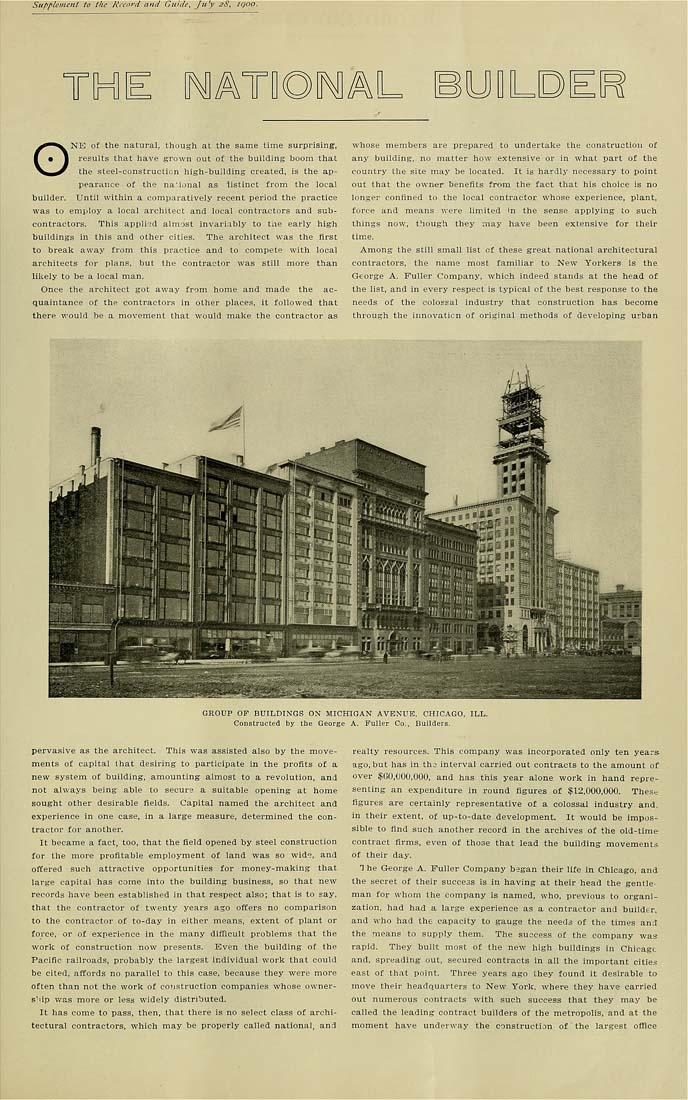Columbia University Libraries Digital Collections: The Real Estate Record
Use your browser's Print function to print these pages.
Real estate record and builders' guide: v. 66, no. 1689: July 28, 1900: Supplement

Text version:
Please note: this text may be incomplete. For more information about this OCR, view About OCR text.
Suppiement to ihe R,-cnrd and Guide, Ju'y sS, igoo. [1—n ru e: B ONE of the natural, though at the same time surprising, results that have grown out of the building boom that the steel-construction high-building created, is the ap¬ pearance of the na'ional as listinct from the local builder. Until within a comparatively recent period the practice was to employ a local architect and local contractors and sub¬ contractors. This applied almost invariably to the early high buildings in this and other cities. The architect was the first to break away from this practice and to compete with local architects for plans, hut the contractor was still more than likely to be a local man. Once the architect got away from home and made the ac¬ quaintance of the contractors in other places, it followed that there would be a movement that would make the contractor as whose members are prepared to undertake the construction of any building, no matter how extensive or in what part of the country the site may be located. It is hardly necessary to point out that the owner benefits from the fact that his choice is no longer confined to the local contractor whose experience, plant, force and means were limited in the sense applying to such things now, though they may have been extensive for their time. Among the still small list of these great national architectural contractors, the name most familiar to New Yorkers is the George A, Puller Company, which indeed stands at the head of the list, and in every respect is typical of the best response to the needs of the colossal industry that construction has become through the iiinovaticn of ori.ginal methods of developing urban GROUP OF" BUILDINGS ON MICHIGAN AVENUE, CHICAGO, ILL. Constructed by tbe George A. Fuller Co,. Builders. pervasive as the architect. This was assisted also by the move¬ ments of capital that desiring to participate in the profits of a new system of building, amounting almost to a revolution, and not always being able to secure a suitable opening at home sought other desirable fields. Capital named the architect and experience in one case, in a large measure, determined ttie con¬ tractor for another. It became a fact, too, that the field opened by steel construction for the more profitable employment of land was so wide, and offered such attractive opportunities for money-making that large capital has come into the building business, so that new records have been established in that respect also; that is to say, that the contractor of twenty years ago offers no comparison to the contractor of to-day in either means, extent of plant or force, or of experience in the many difTicult problems that the work of construction now presents. Even the building of the Pacific railroads, probably the largest individual work that could be cited, affords no parallel to this case, because they were more often than not the work of cOTistruction companies whose owner- s"np v.'as more or less widely distributed. It has come to pass, then, that there is no select class of archi¬ tectural contractors, which may be properly called national, and realty resources. This company was incorporated only ten years ago, but has in thi interval carried out contracts to the amount of over $00,000,000, and has this year alone work in hand repre¬ senting an expenditure in round figures of $12,000,000. These figures are certainly representative of a colossal industry and, in their extent, of up-to-date development. It would be impos¬ sible to find such another record in the archives of the old-time contract firms, even of those that lead the building movement* of their day. 1 he George A, Fuller Company began their life in Chicago, and the secret of their success is in having at their head the gentle¬ man for whom the company is named, who, previous to organi¬ zation, had had a large experience as a contractor and builder, and who had the capacity to gauge the needs of the times and the means to supply them. The success of the company was rapid. They built most of the new high buildings in Chicagc and, spreading out, secured contracts in all the important cities east of that point. Three years ago they found it desirable to move their headquarters to New York, where they have carried out numerous contracts with such success that they may be called the leading contract builders of the metropolis, and at the moment have underway the construction of the largest office I